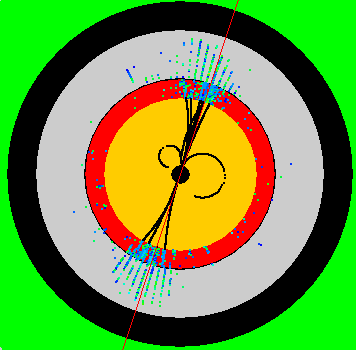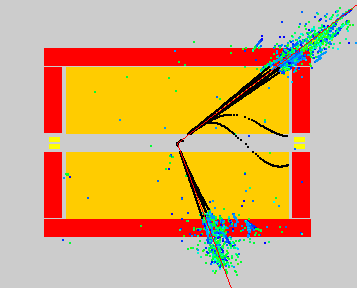[Feedback][Tutorial Contents][hep.lcd Home]
![]()
There are utilities for finding jets and analyzing event shapes in the hep.lcd.physics package. The examples below show how to use this package.
The Jetset event shape and thrust routines have been converted to Java and can be found
in the hep.lcd.physics.EventShape![]() class. To use
the utility it is first necessary to create EventShape object, and then to use its
setEvent method to pass in the data to be analyzed. The argument to the setEvent method is
an Enumeration of either 3-vectors (hep.lcd.physics.IHep3Vector
class. To use
the utility it is first necessary to create EventShape object, and then to use its
setEvent method to pass in the data to be analyzed. The argument to the setEvent method is
an Enumeration of either 3-vectors (hep.lcd.physics.IHep3Vector![]() ) or 4-vectors (hep.lcd.physics.IHepLorentzVector
) or 4-vectors (hep.lcd.physics.IHepLorentzVector![]() ), and optionally
a hep.lcd.util.predicate.Predicate
), and optionally
a hep.lcd.util.predicate.Predicate![]() which is used to
select which elements of the Enumeration are actually used in the event shape
calculations. The example below passes an Enumeration of the MC truth particles to the
setEvent method, along with a predicate which accepts only final-state, charger.particles.
which is used to
select which elements of the Enumeration are actually used in the event shape
calculations. The example below passes an Enumeration of the MC truth particles to the
setEvent method, along with a predicate which accepts only final-state, charger.particles.
import hep.analysis.*; import hep.lcd.event.*; import hep.lcd.util.predicate.*; import hep.physics.*; import hep.lcd.physics.*; import java.util.*; final public class ShapeAnalysis extends EventAnalyzer { // Create an instance of the EventShape utility EventShape es = new EventShape(); // Create a Predicate that accepts final state charged particles Predicate predicate = new Predicate() { public boolean accept(Object in) { Particle p = (Particle) in; if (p.getStatusCode() != Particle.FINALSTATE) return false; if (p.getType().getCharge() == 0) return false; return true; } }; public ShapeAnalysis() { } public void processEvent(final EventData d) { final LCDEvent event = (LCDEvent) d; // We will use the MC truth in this example ParticleVector pv = event.getMCParticles(); es.setEvent(pv.particles(),predicate); histogram("Thrust").fill(es.thrust().x()); histogram("Oblateness").fill(es.oblateness()); } }
The jet finder consists of an interface hep.lcd.physics.IJetFinder![]() which is
implemented by all jet finding algorithms, and a set of concrete jet finding algorithms.
Currently there are two concrete JetFinder classes: hep.lcd.physics.JadeEJetFinder
which is
implemented by all jet finding algorithms, and a set of concrete jet finding algorithms.
Currently there are two concrete JetFinder classes: hep.lcd.physics.JadeEJetFinder![]() and
hep.lcd.physics.DurhamJetFinder
and
hep.lcd.physics.DurhamJetFinder![]() . So far
the JadeEJetFinder appears to work best for LCD events. To use a jet finder it is first
necessary to create an instance of the the jet finder, and then invoke the setEvent method
to pass it the data to be analysed. The argument(s) to the setEvent method is(are) the
same as for the EventShape class described above. The following example program uses the
same predicate as the previous example.
. So far
the JadeEJetFinder appears to work best for LCD events. To use a jet finder it is first
necessary to create an instance of the the jet finder, and then invoke the setEvent method
to pass it the data to be analysed. The argument(s) to the setEvent method is(are) the
same as for the EventShape class described above. The following example program uses the
same predicate as the previous example.
import hep.analysis.*; import hep.lcd.event.*; import hep.lcd.util.predicate.*; import hep.physics.*; import hep.lcd.physics.*; import java.util.*; final public class JetFinder extends EventAnalyzer { // Create a JadeEJetFinder with a ycut of 0.02 AbstractJetFinder jetFinder = new JadeEJetFinder(0.02); // Create a Predicate that accepts final state charged particles Predicate predicate = new Predicate() { public boolean accept(Object in) { Particle p = (Particle) in; if (p.getStatusCode() != Particle.FINALSTATE) return false; if (p.getType().getCharge() == 0) return false; return true; } }; public JetFinder() { } public void processEvent(final EventData d) { final LCDEvent event = (LCDEvent) d; // We will use the MC truth in this example to find jets ParticleVector pv = event.getMCParticles(); jetFinder.setEvent(pv.particles(),predicate); // Fill some diagnostic histograms histogram("Njets").fill(jetFinder.njets()); histogram("Fewest Tracks").fill(jetFinder.fewestTracks()); double totalJetEnergy = 0; double totalParticleEnergy = 0; for (int ijet =0; ijet<jetFinder.njets(); ijet++) { totalJetEnergy += jetFinder.jet(ijet).t(); histogram("Jet Energy").fill(jetFinder.jet(ijet).t()); histogram("Particles in Jet").fill(jetFinder.nParticlesPerJet(ijet)); // loop over all the tracks in the jet, and add up there energy // (should be the same as the jet energy) double etot = 0; Enumeration e = jetFinder.particlesInJet(ijet); while (e.hasMoreElements()) etot += ((Particle) e.nextElement()).getEnergy(); histogram("Etot").fill(etot); totalParticleEnergy += etot; } histogram("Total Jet Energy").fill(totalJetEnergy); histogram("Total Particle Energy").fill(totalParticleEnergy); } }
To display the found jets on the LCD event display it is only necessary to fill the jet vectors into the event header. This can be achived by adding the following three lines after the call to jetFinder.setEvent in the above example.
Vector v = new Vector(); for (int i=0; i<jetFinder.njets(); i++) v.addElement(jetFinder.jet(i)); event.put("Jets",v);
This should result in event displays looking something like this:


This example shows how to vary the Jet Finders y-cut to create a histogram showing how the average number of jets varies as a functionm of y-cut. Note that the jet finder automatically reruns the jet finding algorithm when the y-cut is changed.
import hep.analysis.*; import hep.lcd.event.*; import hep.lcd.util.predicate.*; import hep.physics.*; import hep.lcd.physics.*; import java.util.*; final public class YCut extends EventAnalyzer { // Create a DurhamJetFinder with a ycut of 0.02 DurhamJetFinder jetFinder = new DurhamJetFinder(0.02); // Create a Predicate that accepts final state charged particles Predicate predicate = new Predicate() { public boolean accept(Object in) { Particle p = (Particle) in; if (p.getStatusCode() != Particle.FINALSTATE) return false; if (p.getType().getCharge() == 0) return false; return true; } }; public YCut() { histogram("NJets vs Y Cut").setPartition(new FixedMeanPartition(0,.1,50)); } public void processEvent(final EventData d) { final LCDEvent event = (LCDEvent) d; // We will use the MC truth in this example to find jets ParticleVector pv = event.getMCParticles(); jetFinder.setEvent(pv.particles(),predicate); // Fill some diagnostic histograms for (double ycut=0.001; ycut<0.1; ycut += 0.002) { jetFinder.setYCut(ycut); histogram("NJets vs Y Cut").fill(ycut,jetFinder.njets()); } } }